China Railway Construction Bundle
Who Really Owns China Railway Construction Company?
Delving into the ownership of China Railway Construction Company (CRCC) is key to understanding its global impact. From its roots in the People's Liberation Army to its current status as a construction behemoth, CRCC's evolution reflects China's infrastructure ambitions. Understanding the dynamics of its ownership structure is crucial for anyone navigating the complexities of the Chinese construction industry.
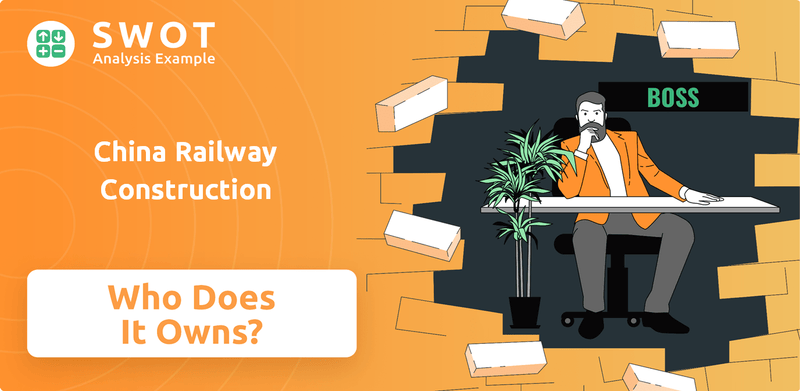
The China Railway Construction SWOT Analysis provides a deeper understanding of the company's strengths, weaknesses, opportunities, and threats, all influenced by CRCC's ownership. This exploration of CRCC ownership will illuminate the interplay between the Chinese government and its influence on CRCC shareholders, its access to capital, and its strategic direction. Knowing who controls China Railway Construction Company is essential for investors and stakeholders alike, offering insights into its long-term prospects and strategic alignment within the Chinese state-owned enterprises landscape.
Who Founded China Railway Construction?
The origins of the China Railway Construction Company (CRCC) are rooted in the railway corps of the People's Liberation Army, established in 1948. This structure inherently meant that the initial ownership was state-controlled, rather than being founded by private individuals with specific equity arrangements. The primary 'founders' were effectively the People's Republic of China, utilizing its military and governmental bodies to guide its formation and early operations.
From its inception, CRCC was a direct instrument of national development, with funding, resources, and strategic directives provided by various arms of the Chinese government. Unlike private companies, there were no angel investors or initial private shareholders. The company's operations and direction were governed by state planning and political objectives, reflecting its status as a state-owned enterprise.
The early 'backers' of CRCC were the different branches of the Chinese government, which supplied direct funding, resources, and strategic directives. The founding vision was aligned with national infrastructure development, reflecting the centralized control inherent in its state-owned status from the beginning. This contrasts sharply with private enterprises, where ownership is typically defined by individual equity stakes and shareholder agreements.
The initial ownership structure of CRCC was inherently state-controlled. The People's Republic of China, through its military and governmental bodies, directed its formation and initial operations.
The Chinese government provided direct funding, resources, and strategic directives. There were no private investors in the initial phase.
The founding vision was unequivocally aligned with national infrastructure development and strategic objectives. This reflected the centralized control inherent in its state-owned status.
Its operations and direction were governed by state planning and political objectives. Agreements such as vesting schedules were not applicable.
Any 'ownership disputes' or 'buyouts' would have occurred within the framework of state policy and departmental reorganizations, rather than private equity transactions.
There were no individual founders with personal equity stakes or shareholding percentages at inception in the way a private company would be established.
The ownership structure of CRCC, as a Chinese state-owned enterprise, is primarily controlled by the Government of China. The specific shareholding details and the influence of the Chinese government are crucial aspects of understanding Growth Strategy of China Railway Construction. As of the latest available data, the majority of CRCC's shares are held by entities directly controlled by the state, ensuring that the company's operations align with national strategic goals. This ownership model significantly impacts CRCC's governance, financial decisions, and project selection, reflecting the broader policies of the Chinese construction industry.
Understanding the ownership structure of CRCC is crucial for investors and stakeholders.
- CRCC is a state-owned enterprise, with the Government of China as the primary shareholder.
- The initial ownership was established by the People's Republic of China, through its military and governmental bodies.
- The company's operations are guided by state planning and strategic objectives, reflecting its state-owned status.
- There were no individual founders with personal equity stakes at inception.
- The ownership structure influences CRCC's governance, financial decisions, and project selection.
China Railway Construction SWOT Analysis
- Complete SWOT Breakdown
- Fully Customizable
- Editable in Excel & Word
- Professional Formatting
- Investor-Ready Format
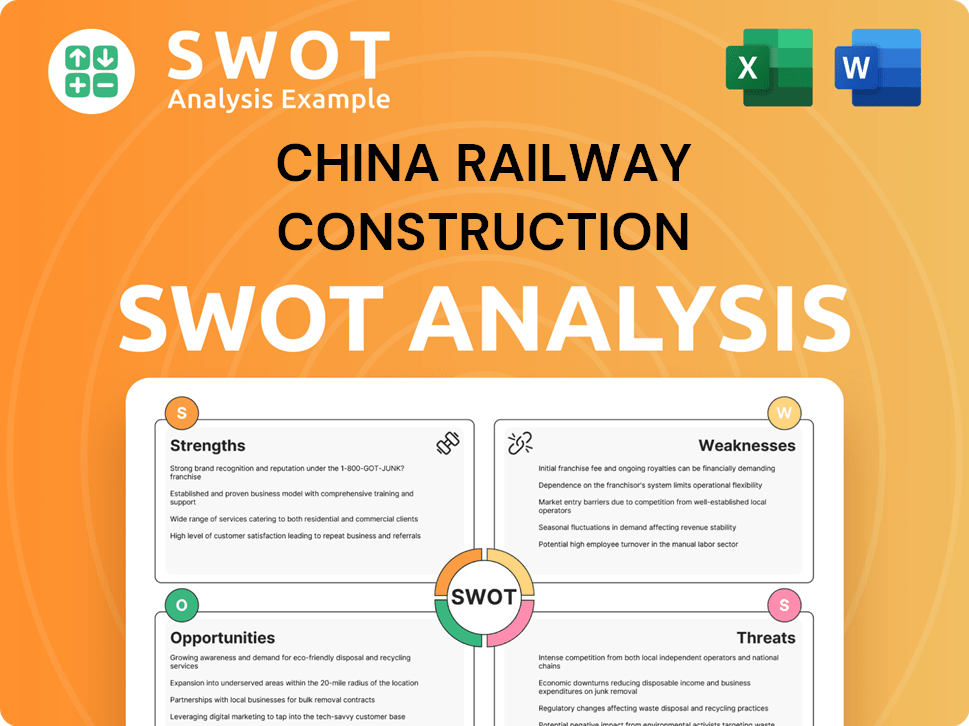
How Has China Railway Construction’s Ownership Changed Over Time?
The evolution of China Railway Construction Company (CRCC) from a state-owned entity to a publicly listed company marks a significant shift in its ownership structure. This transition was primarily driven by its initial public offering (IPO) in 2008. The dual listing on the Hong Kong Stock Exchange (H shares) on March 10, 2008, and the Shanghai Stock Exchange (A shares) on March 12, 2008, provided CRCC with access to capital markets, enabling it to fund large-scale infrastructure projects. This strategic move was pivotal for the company's growth and expansion within the Chinese construction industry and internationally.
Following the IPO, the ownership structure of CRCC evolved to include a mix of state-owned entities, institutional investors, mutual funds, and individual shareholders. The Government of China, through the Chinese state-owned enterprises, maintained significant control. The IPO enhanced CRCC's ability to undertake large-scale projects, both domestically and globally. The company's governance remains closely aligned with national development objectives.
| Event | Date | Impact on Ownership |
|---|---|---|
| H Share Listing | March 10, 2008 | Increased access to international capital markets. |
| A Share Listing | March 12, 2008 | Expanded access to domestic capital markets. |
| Post-IPO Ownership | 2008-Present | Diversified shareholder base with continued state control. |
The primary shareholder of CRCC is China Railway Construction Corporation (CRCC Group), a state-owned enterprise supervised by the State-owned Assets Supervision and Administration Commission of the State Council (SASAC). As of December 31, 2024, CRCC Group typically holds a majority stake, often exceeding 50% of the total shares. For example, CRCC Group held approximately 52.6% of CRCC's total share capital. Other major stakeholders include institutional investors, both domestic and international, holding significant portions of the publicly traded A and H shares. This structure ensures that while CRCC operates as a public company, it remains closely aligned with the strategic goals of the Chinese government. To learn more about the company's background, you can read this Brief History of China Railway Construction.
CRCC's ownership structure balances state control with public market participation.
- CRCC Group, a state-owned entity, is the primary shareholder.
- Institutional investors hold substantial portions of the publicly traded shares.
- The IPO in 2008 was a pivotal event in the company's ownership evolution.
- The structure supports both capital access and alignment with national objectives.
China Railway Construction PESTLE Analysis
- Covers All 6 PESTLE Categories
- No Research Needed – Save Hours of Work
- Built by Experts, Trusted by Consultants
- Instant Download, Ready to Use
- 100% Editable, Fully Customizable
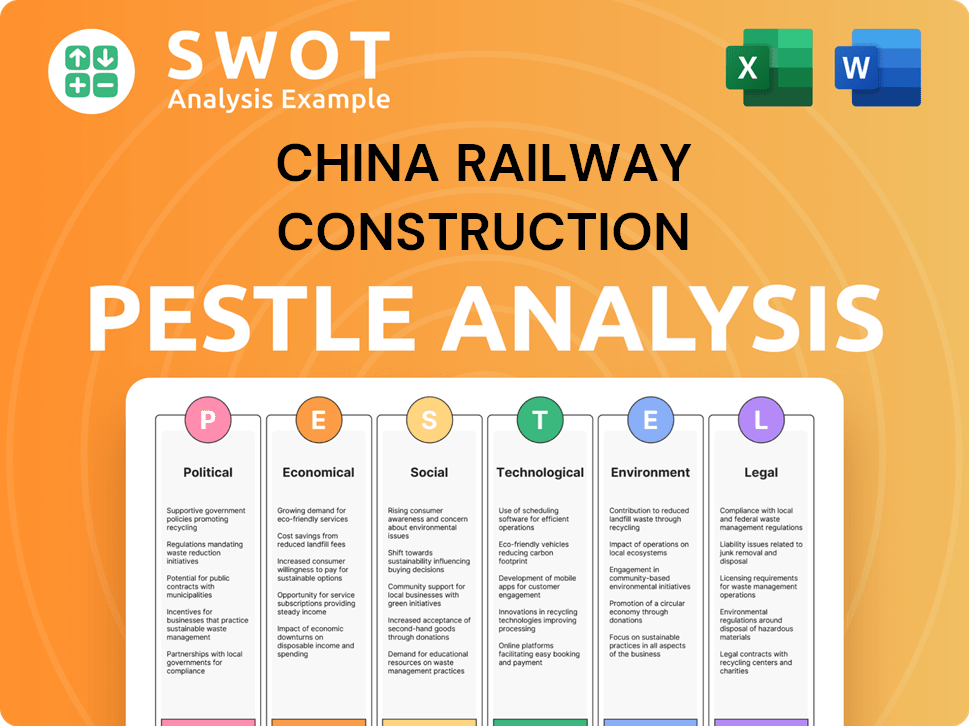
Who Sits on China Railway Construction’s Board?
The Board of Directors of China Railway Construction Company (CRCC) reflects its unique structure as a major player in the Chinese construction industry. As of early 2025, the board typically includes executive directors, non-executive directors, and independent non-executive directors. Executive directors usually include the Chairman and President, often appointed from within the state-owned system. Non-executive directors often represent the interests of the controlling shareholder, China Railway Construction Corporation (CRCC Group), which is ultimately controlled by the State-owned Assets Supervision and Administration Commission (SASAC).
The composition of the board is crucial because it directly influences the strategic direction and governance of CRCC. The presence of representatives from the controlling shareholder ensures alignment with the goals of the Government of China, particularly in infrastructure development. Independent non-executive directors are also present to ensure compliance with stock exchange regulations and to provide a degree of oversight.
| Director Category | Role | Influence |
|---|---|---|
| Executive Directors | Chairman, President, and other senior executives | Oversee day-to-day operations and strategic planning. |
| Non-Executive Directors | Represent the interests of CRCC Group | Ensure alignment with the controlling shareholder’s objectives. |
| Independent Non-Executive Directors | Provide oversight and ensure compliance with regulations | Offer an independent perspective on corporate governance. |
The voting structure of CRCC generally follows a one-share-one-vote principle for both A and H shares. However, the significant majority stake held by CRCC Group grants it substantial control over major strategic decisions, board appointments, and corporate governance matters. This CRCC ownership structure, with the state as the primary shareholder, ensures that CRCC's operations align with national infrastructure development goals. For more insights, consider exploring the Competitors Landscape of China Railway Construction.
CRCC's board is a blend of state representatives and independent directors, reflecting its state-owned enterprise status.
- The controlling shareholder, CRCC Group, holds significant voting power.
- The board's decisions are heavily influenced by the strategic direction set by the Chinese government.
- Governance is primarily managed internally and through regulatory oversight.
- The state's influence ensures alignment with national infrastructure goals.
China Railway Construction Business Model Canvas
- Complete 9-Block Business Model Canvas
- Effortlessly Communicate Your Business Strategy
- Investor-Ready BMC Format
- 100% Editable and Customizable
- Clear and Structured Layout
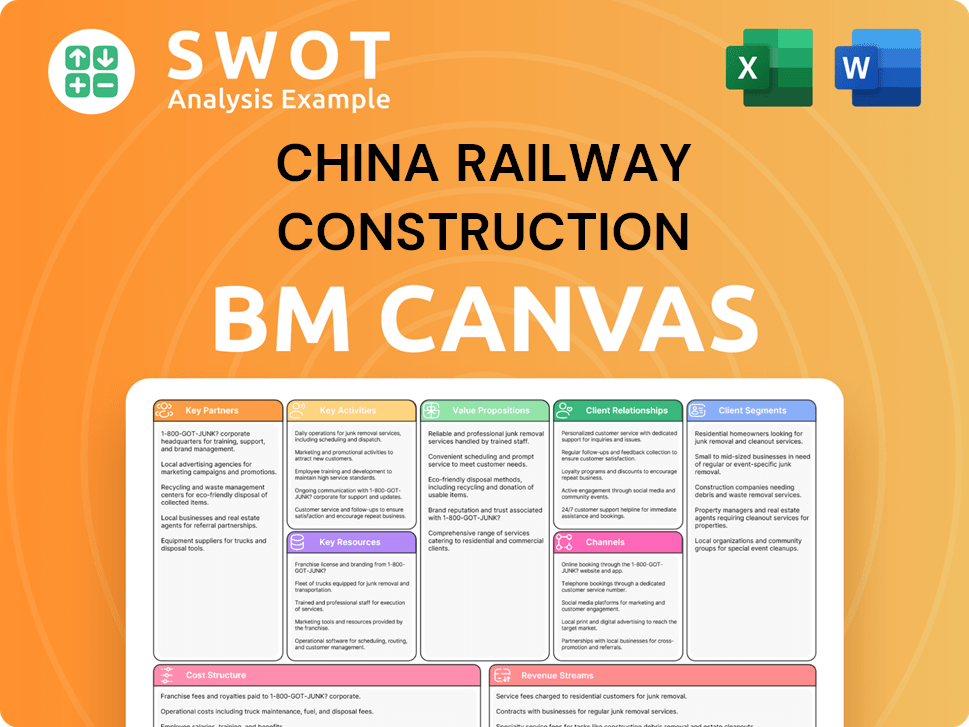
What Recent Changes Have Shaped China Railway Construction’s Ownership Landscape?
Over the past few years, the China Railway Construction Company (CRCC) has maintained a stable ownership structure. The ultimate control remains with the CRCC Group, a state-owned enterprise overseen by the State-owned Assets Supervision and Administration Commission of the State Council (SASAC). This structure is a key characteristic of the company, reflecting its role within the Chinese construction industry and its alignment with national strategic initiatives. The Government of China, through SASAC, continues to exert significant influence over CRCC's operations and strategic direction.
Recent developments have seen CRCC engaging in strategic share buybacks, particularly of its A-shares. This action aims to boost shareholder value and stabilize the stock price amidst market fluctuations. For example, in late 2023 and early 2024, there were announcements regarding significant share repurchases. These repurchases are part of a broader trend among Chinese state-owned enterprises to bolster market confidence. The company's adherence to state control is a defining factor, with no indications of planned privatization or significant changes in the fundamental ownership structure in the near future.
| Ownership Aspect | Details | Recent Trends (2022-2025) |
|---|---|---|
| Controlling Shareholder | CRCC Group | Continued state control, no significant changes. |
| Share Buybacks | A-shares repurchases | Focused on enhancing shareholder value and stabilizing stock price. |
| Strategic Alignment | National initiatives like the Belt and Road Initiative | Consistent alignment with government objectives. |
The ownership structure of CRCC reflects its status as a key player in the Chinese construction industry. The company's operations are closely tied to the strategic goals of the Government of China. For further insights into the company's approach, consider exploring the Marketing Strategy of China Railway Construction. This alignment is further reinforced by the company's involvement in significant infrastructure projects and its strategic alignment with national initiatives.
CRCC's ownership structure has remained stable, with CRCC Group maintaining control. This stability is a key factor in its operations.
The company has undertaken share buybacks to boost shareholder value. This reflects broader market confidence.
The Government of China significantly influences CRCC's operations through SASAC. This influence is crucial.
CRCC aligns its strategies with national initiatives, such as the Belt and Road Initiative. This is a key factor.
China Railway Construction Porter's Five Forces Analysis
- Covers All 5 Competitive Forces in Detail
- Structured for Consultants, Students, and Founders
- 100% Editable in Microsoft Word & Excel
- Instant Digital Download – Use Immediately
- Compatible with Mac & PC – Fully Unlocked
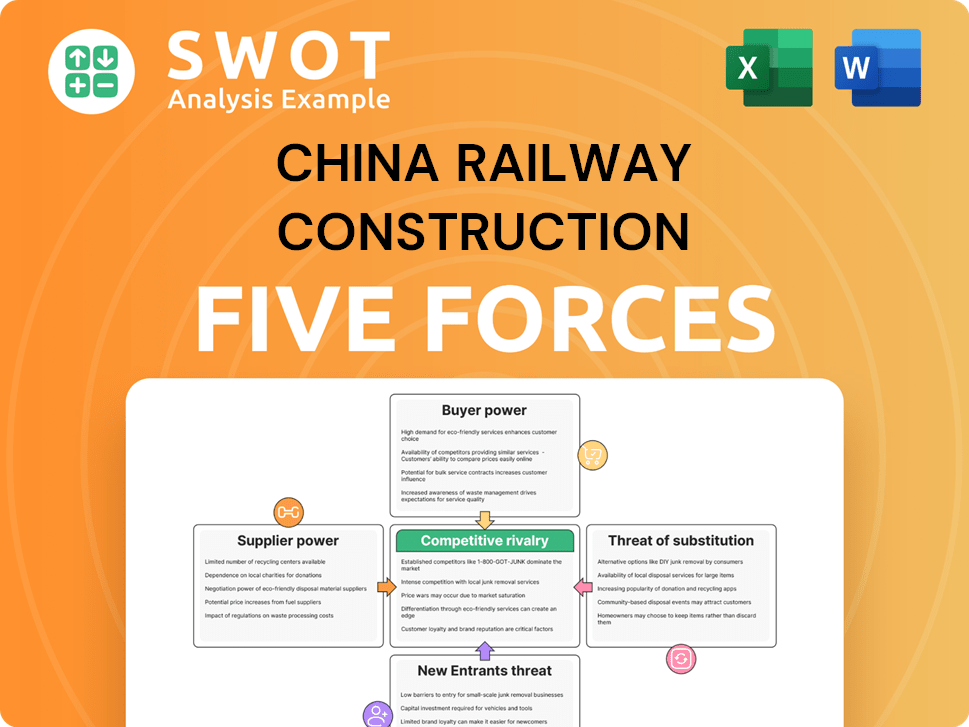
Related Blogs
- What are Mission Vision & Core Values of China Railway Construction Company?
- What is Competitive Landscape of China Railway Construction Company?
- What is Growth Strategy and Future Prospects of China Railway Construction Company?
- How Does China Railway Construction Company Work?
- What is Sales and Marketing Strategy of China Railway Construction Company?
- What is Brief History of China Railway Construction Company?
- What is Customer Demographics and Target Market of China Railway Construction Company?
Disclaimer
All information, articles, and product details provided on this website are for general informational and educational purposes only. We do not claim any ownership over, nor do we intend to infringe upon, any trademarks, copyrights, logos, brand names, or other intellectual property mentioned or depicted on this site. Such intellectual property remains the property of its respective owners, and any references here are made solely for identification or informational purposes, without implying any affiliation, endorsement, or partnership.
We make no representations or warranties, express or implied, regarding the accuracy, completeness, or suitability of any content or products presented. Nothing on this website should be construed as legal, tax, investment, financial, medical, or other professional advice. In addition, no part of this site—including articles or product references—constitutes a solicitation, recommendation, endorsement, advertisement, or offer to buy or sell any securities, franchises, or other financial instruments, particularly in jurisdictions where such activity would be unlawful.
All content is of a general nature and may not address the specific circumstances of any individual or entity. It is not a substitute for professional advice or services. Any actions you take based on the information provided here are strictly at your own risk. You accept full responsibility for any decisions or outcomes arising from your use of this website and agree to release us from any liability in connection with your use of, or reliance upon, the content or products found herein.